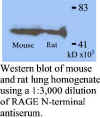The Receptor for Advanced
Glycosylated End Products (RAGE) is a member of the immunoglobulin superfamily of cell
surface molecules that binds molecules that have been irreversibly
modified by non-enzymatic glycation and oxidation, and are know as
advanced glycation end products (AGEs).
It is expressed by endothelium, mononuclear phagocytes, neurons and
smooth muscle cells. Whereas
RAGE is present at high levels during development, especially in the
central nervous system, its levels decline during maturity.
The increased expression of RAGE is associated with
several pathological states, such as diabetic vasculopathy,
retinopathy and neuropathy, and other disorders, including Alzheimer’s
disease and immune/inflammatory reactions of the vessel walls. In diabetic tissues, the production of RAGE is due to the
overproduction of AGEs that eventually overwhelm the protective properties
of RAGE. This results in
oxidative stress and endothelial cell dysfunction that leads to vascular
disease in diabetics. In the
brain, RAGE also binds amyloid beta (Ab).
Because Ab
is overproduced in neurons and vessels in the brains of Alzheimer disease,
this leads to the hyperstimulation of RAGE.
The RAGE-Ab interaction is thought to result in oxidative stress
leading to neuronal degeneration.
the
brain, RAGE also binds amyloid beta (Ab).
Because Ab
is overproduced in neurons and vessels in the brains of Alzheimer disease,
this leads to the hyperstimulation of RAGE.
The RAGE-Ab interaction is thought to result in oxidative stress
leading to neuronal degeneration.
A goat antiserum to a synthetic peptide that corresponds to
amino acids 42-59 of the N-terminus of human RAGE protein is currently
available. This antiserum has been shown to be immunoreactive with the
unconjugated immunizing peptide by ELISA.
It will also immunolabel vessels from diabetic tissues and vessels
and neurons from the brains of AD patients in formalin-fixed,
paraffin-embedded tissues. This antibody should be a valuable tool for
scientists working to understand the role of RAGE in diabetes and AD.
42-59 of the N-terminus of human RAGE protein is currently
available. This antiserum has been shown to be immunoreactive with the
unconjugated immunizing peptide by ELISA.
It will also immunolabel vessels from diabetic tissues and vessels
and neurons from the brains of AD patients in formalin-fixed,
paraffin-embedded tissues. This antibody should be a valuable tool for
scientists working to understand the role of RAGE in diabetes and AD.
This antiserum was produced using proprietary methodology
whereby the peptide is attached to a carrier that elicits minimal
immunoreactivity so that the antiserum has a higher degree of specificity
for the peptide. Since there
is no overwhelming production of interfering antibodies to the carrier,
this antiserum can routinely be used without further purification. Pseud-Immune™ control immune serum (Cat no. GPA018E) from a mock
immunized animal is available to be used in conjunction with this antibody
as well as the immunizing peptide (Cat no. HSP017N), which can be used to
neutralize immunoreactivity.
Manufacturing
Reference:
Southwest Immunology,
Inc., unpublished results.
 Polyclonal Anti-human
Polyclonal Anti-human